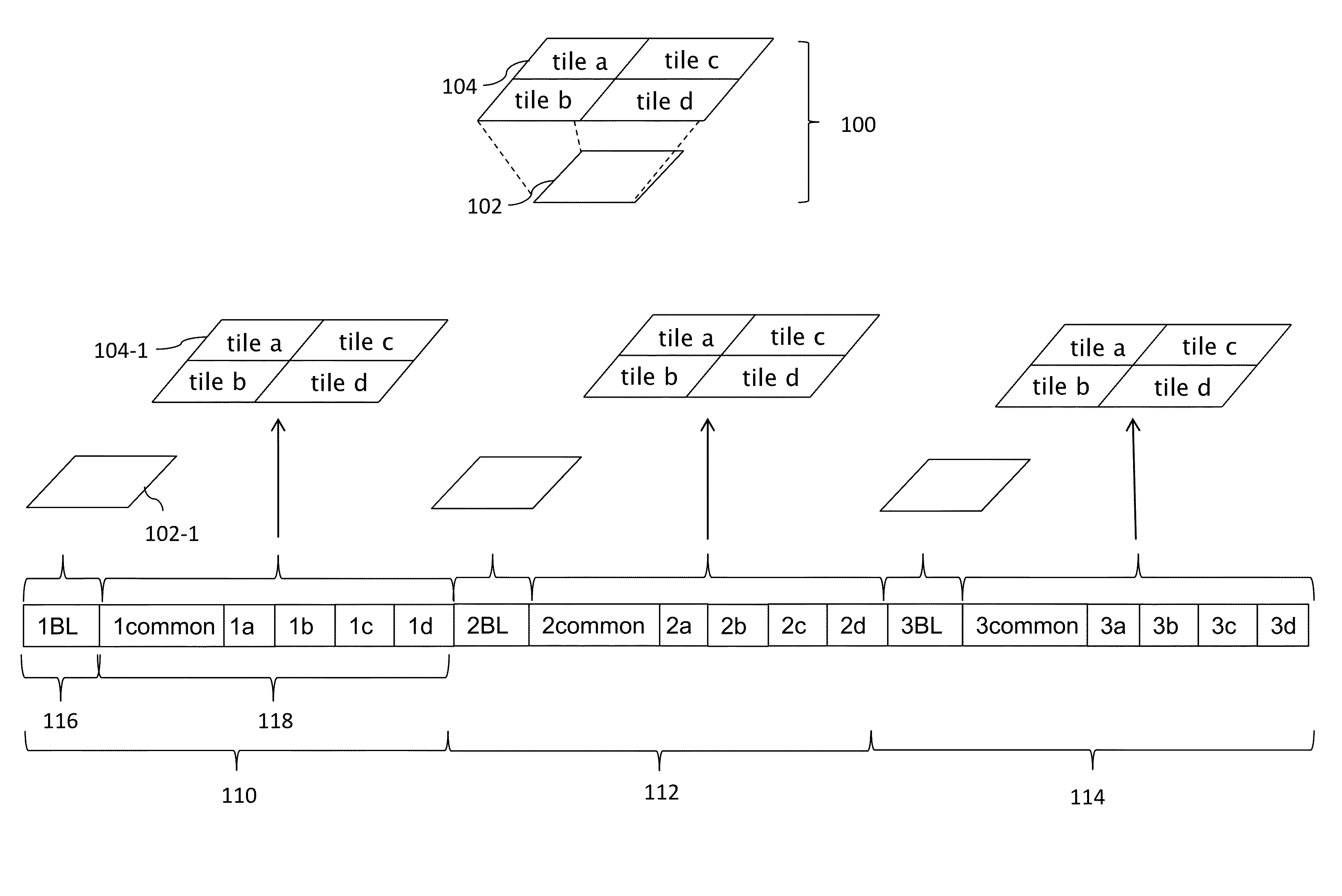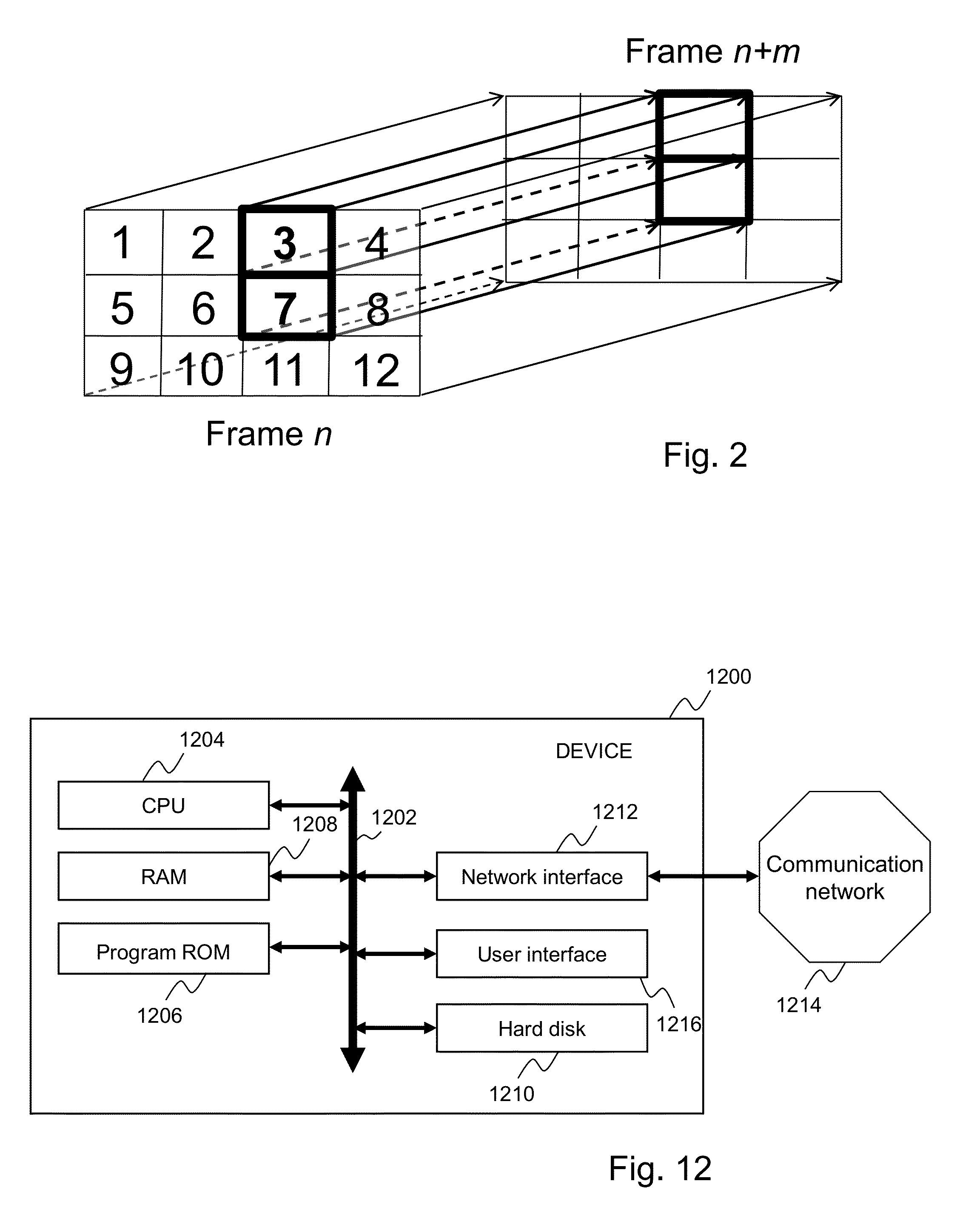Method, device, and computer program for encapsulating scalable partitioned timed media data
a timed media and data encapsulation technology, applied in the field of timed media data encapsulation, can solve the problems of not having all the resources of receiving and video decoding devices, and none of these strategies allowing efficient access to specific tiles in the context of http streaming, so as to improve parsing efficiency and extraction
- Summary
- Abstract
- Description
- Claims
- Application Information
AI Technical Summary
Benefits of technology
Problems solved by technology
Method used
Image
Examples
first embodiment
[0194]FIG. 6, comprising FIGS. 6a and 6b, illustrates an example of encapsulating a tiled scalable video stream of the HEVC type as a single track into an mp4 file, according to a
[0195]As illustrated in FIG. 6a, it is assumed that the video stream comprises a base layer 600 that can be enhanced by the two independent spatial enhancement layers 601 and 602. Enhancement layer 601, referenced enhancement layer A, comprises tiles T1 and T2, and enhancement layer 602, referenced enhancement layer B, comprises tiles T1, T2, T3, and T4 (tile T1 and T2 of enhancement layer A being different from tiles T1 and T2 of enhancement layer B).
[0196]Turning to FIG. 6b, in order to encapsulate the tiled scalable video stream encoded according to the HEVC standard into mp4 file 610, video data are stored in mdat box 612 as a list of samples comprising, in particular, sample 620. Each sample is encoded as a set of one or more NAL units. As illustrated, sample 620 comprises interlaced NAL units 621 to 6...
second embodiment
[0206]FIG. 7, comprising FIGS. 7a and 7b, illustrates an example of encapsulating a tiled scalable video stream of the HEVC type as a single track into an mp4 file, allowing reducing the amount of duplicated information.
[0207]As illustrated in FIG. 7a, that is similar to FIG. 6a, it is assumed that the video stream comprises a base layer 700 that can be enhanced by the two independent spatial enhancement layers 701 and 702. Enhancement layer 701, referenced enhancement layer A, comprises tiles T1 and T2, and enhancement layer 702, referenced enhancement layer B, comprises tiles T1, T2, T3, and T4 (tile T1 and T2 of enhancement layer A being different from tiles T1 and T2 of enhancement layer B).
[0208]Again, turning to FIG. 7b, in order to encapsulate the tiled scalable video stream encoded according to the HEVC standard into mp4 file 710, video data are stored in mdat box 712 as a list of samples comprising, in particular, sample 720. Each sample is encoded as a set of one or more ...
third embodiment
[0232]FIG. 9, comprising FIGS. 9a and 9b, illustrates an example of encapsulating a tiled scalable video stream of the HEVC type as a single track into an mp4 file, according to a This embodiment is particularly adapted to the case according to which the number of NAL units per sample varies from one sample to another. FIG. 10 illustrates tile and scalable layer descriptors, according to a particular embodiment, to encapsulate an HEVC bit-stream.
[0233]As illustrated in FIG. 9a, that is similar to FIGS. 6a and 7a, it is assumed that the video stream comprises a base layer 900 that can be enhanced by the two independent spatial enhancement layers 901 and 902. Enhancement layer 901, referenced enhancement layer A, comprises tiles T1 and T2, and enhancement layer 902, referenced enhancement layer B, comprises tiles T1, T2, T3, and T4 (tile T1 and T2 of enhancement layer A being different from tiles T1 and T2 of enhancement layer B).
[0234]Again, turning to FIG. 9b, in order to encapsula...
PUM
 Login to View More
Login to View More Abstract
Description
Claims
Application Information
 Login to View More
Login to View More - R&D
- Intellectual Property
- Life Sciences
- Materials
- Tech Scout
- Unparalleled Data Quality
- Higher Quality Content
- 60% Fewer Hallucinations
Browse by: Latest US Patents, China's latest patents, Technical Efficacy Thesaurus, Application Domain, Technology Topic, Popular Technical Reports.
© 2025 PatSnap. All rights reserved.Legal|Privacy policy|Modern Slavery Act Transparency Statement|Sitemap|About US| Contact US: help@patsnap.com



